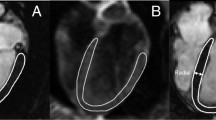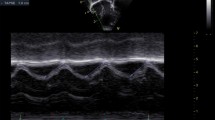Abstract
Myocardial function is impaired by ischaemia, and it remains depressed during reperfusion following short periods of ischaemia (stunned myocardium). We tested whether ischaemic and reperfusion dysfunction, in particular the time course of its recovery, can be distinguished by postextrasystolic potentiation (PESP). In eight open-chest dogs, posterior systolic wall thickening (sonomicrometry) was reduced by graded occlusion of the left circumflex coronary artery (LCX) from 17.4±6.8% (SD) during control conditions to 10.7±1.3% (mild ischaemic dysfunction), 7.2±2.3% (moderate ischaemic dysfunction), 3.6±1.4% (severe ischaemic dysfunction), and -4.4±3.6% (complete coronary occlusion). Extrasystoles with constant prematurity and a fully compensated postextrasystolic interval were induced after at least 4 min steady-state ischaemia. After each ischaemic period full recovery of posterior systolic wall thickening was assured. During 8 h of reperfusion following a 15-min LCX occlusion, extrasystoles were induced when posterior systolic wall thickening was comparable to one degree of the preceding ischaemic dysfunction. The increases in posterior systolic wall thickening induced by PESP were 10.5±5.8% during control conditions, during ischaemia they were 11.5±3.5% (mild dysfunction), 12.3±4.6% (moderate dysfunction), 12.6±4.1% (severe dysfunction) and 10.4±4.4% (complete coronary occlusion), and during reperfusion they were 12.8±8.2% (severe dysfunction), 13.0±9.7% (moderate dysfunction) and 10.7±2.2% (mild dysfunction). These increments in systolic wall thickening as well as those in ejection thickening were not significantly different. PESP can thus not distinguish between ischaemic and reperfusion dysfunction nor between different degrees of myocardial dysfunction.
Similar content being viewed by others
References
Becker LC, Levine JH, DiPaula AF, Guarnieri T, Aversano T (1986) Reversal of dysfunction in postischemic stunned myocardium by epinephrine and postextrasystolic potentiation. J Am Coll Cardiol 7:580–589
Boden WE, Liang CS, Hood WB Jr (1980) Postextrasystolic potentiation of regional mechanical performance during prolonged myocardial ischemia in the dog. Circulation 61:1063–1075
Cohen MV, Downey JM (1990) Myocardial stunning in dogs: preconditioning effect and influence of coronary collateral flow. Am Heart J 120:282–291
Cooper MW, Lutherer LO, Stanton MW, Lust RM Jr (1986) Postextrasystolic potentiation: regional wall motion before and after revascularization. Am Heart J 111:334–339
Crozatier B (1982) Relations between myocardial blood flow and postextrasystolic potentiation in epicardial and endocardial left ventricular regions early after coronary occlusion in dogs. Circulation 66:938–944
Crozatier B, Franklin D, Theroux P, Tomoike H, Sasayama S, Ross J Jr (1977) Loss of regional ventricular postextrasystolic potentiation after coronary occlusion in dogs. Am J Physiol 233:H392-H398
Dyke SH, Cohn PF, Gorlin R, Sonnenblick EH (1974) Detection of residual myocardical function in coronary artery disease using postextrasystolic potentiation. Circulation 50:694–699
Dyke SH, Urschel CW, Sonnenblick EH, Gorlin R, Cohn PF (1975) Detection of latent function in acutely ischemic myocardium in the dog. Comparison of pharmacologic inotropic stimulation and postextrasystolic potentiation. Circ Res 36:490–497
Gaasch WH, Bing OHL, Cole JS, Hanley HG (1977) Postextrasystolic compliance of the left ventricle. Circulation 56:540–544
Gallagher KP, Kumada T, Koziol JA, McKown MD, Kemper WS, Ross J Jr (1980) Significance of regional wall thickening abnormalities relative to transmural myocardial perfusion in anesthetized dogs. Circulation 62:1266–1274
Gallagher KP, Gerren RA, Stirling MC, Choy M, Dysko RC, McManimon SP, Dunham WR (1986) The distribution of functional impairment across the lateral border of acutely ischemic myocardium. Circ Res 58:570–583
Glower DD, Schaper J, Kapas JS, Hoffmeister HM, Schaper W, Spratt JA, Davis JW, Rankin JS (1987) Relation between reversal of diastolic creep and recovery of systolic function after ischemic myocardial injury in conscious dogs. Circ Res 60:850–860
Guth BD, Martin JF, Heusch G, Ross J Jr (1987) Regional myocardial blood flow, function and metabolism using phosphorus-31 nuclear magnetic resonance spectroscopy during ischemia and reperfusion. J Am Coll Cardiol 10:673–681
Guth BD, Schulz R, Heusch G (1990) Evaluation of parameters for the assessment of regional myocardial contractile function during asynchronous left ventricular contraction. Basic Res Cardiol 85:550–562
Hess OM, Osakada G, Lavelle JF, Gallagher KP, Kemper WS, Ross J Jr (1983) Diastolic myocardial wall stiffness and ventricular relaxation during partial and complete coronary occlusions in the conscious dog. Circ Res 52:387–400
Heusch G, Frehen D, Kröger K, Schulz R, Thämer V (1988) Integrity of sympathetic neurotransmission in stunned myocardium. J Appl Cardiol 3:259–272
Heyndrickx GR, Millard RW, McRitchie RJ, Maroko PR, Vatner SF (1975) Regional myocardial functional and electrophysiological alterations after brief coronary artery occlusion in conscious dogs. J Clin Invest 56:978–985
Heyndrickx GR, Baig H, Nellens P, Leusen I, Fishbein MC, Vatner SF (1978) Depression of regional blood flow and wall thickening after brief coronary occlusions. Am J Physiol 234:H653-H659
Hoffmeister HM, Mauser M, Schaper W (1985) Effect of adenosine and AICAR on ATP content and regional contractile function in reperfused canine myocardium. Basic Res Cardiol 80:445–458
Ito BR, Tate H, Kobayashi M, Schaper W (1987) Reversibly injured, postischemic canine myocardium retains normal contractile reserve. Circ Res 61:834–846
Lew WYW, Chen Z, Guth BD, Covell JW (1985) Mechanisms of augmented segment shortening in nonischemic areas during acute ischemia of the canine left ventricle. Circ Res 56:351–358
Manders WT, Vatner SF (1976) Effects of sodium pentobarbital anesthesia on left ventricular function and distribution of cardiac output in dogs, with particular reference to the mechanism for tachycardia. Circ Res 39:512–517
Raff GL, Glantz SA (1981) Volume loading slows left ventricular isovolumic relaxation rate. Circ Res 48:813–824
Schäfer S, Heusch G (1990) Recruitment of a time-dependent inotropic reserve by postextrasystolic potentiation in normal and reperfused myocardium. Basic Res Cardiol 85:257–269
Schipke J, Heusch G, Schulz R, Thämer V (1987) An easy and quick implantation procedure for the measurement of myocardial wall thickness using sonomicrometry. Basic Res Cardiol 82:411–414
Schulz R, Miyazaki S, Miller M, Thaulow E, Heusch G, Ross J Jr, Guth BD (1989) Consequences of regional inotropic stimulation of ischemic myocardium on regional myocardial blood flow and function in anesthetized swine. Circ Res 64:1116–1126
Thaulow E, Guth BD, Heusch G, Gilpin E, Schulz R, Kröger K, Ross J Jr (1989) Characteristics of regional myocardial stunning after exercise in dogs with chronic coronary stenosis. Am J Physiol257:H113-H119
Theroux P, Ross J Jr, Franklin D, Kemper WS, Sasayama S (1976) Regional myocardial function in the conscious dog during acute coronary occlusion and responses to morphine, propranolol, nitroglycerin, and lidocaine. Circulation 53:302–314
Author information
Authors and Affiliations
Additional information
This study was supported by the Deutsche Forschungsge-meinschaft (He 1320/3-2). cand. med. S. Schäfer was involved in some of these experiments and presented part of the data at the 56th Annual Meeting of the Deutsche Gesellschaft für Herz- und Kreislaufforschung in Mannheim (Z Kardiol 79 [Suppl 1]: 24,1990). Part of the data were also presented at the 11th Congress of the European Society of Cardiology in Nice (Eur Heart J 10 [Suppl]: 242, 1989) and at the 73rd Annual Meeting of the Federation of American Societies for Experimental Biology in New Orleans (FASEB J 3: A841, 1989)
Rights and permissions
About this article
Cite this article
Ehring, T., Heusch, G. Postextrasystolic potentiation does not distinguish ischaemic from stunned myocardium. Pflugers Arch. 418, 453–461 (1991). https://doi.org/10.1007/BF00497773
Received:
Revised:
Accepted:
Issue Date:
DOI: https://doi.org/10.1007/BF00497773




